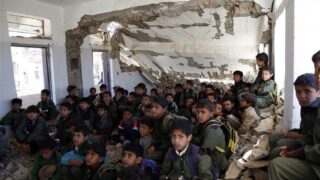Since the middle of the last decade, the drastic effects of global climate change have begun to spread to the local environment in Syria. The drought ended in most of the country, but the al-Jazeera region was hit directly. Waves of the worst droughts ever seen in the history of the region were accompanied by a collapse in the reserve of groundwater in the main river basins. This collapse would not have happened had it not been for the unfettered expansion of well-digging along with the overuse of water in irrigation.
The Syrian government’s liberalization policies were also ignorant of realities on the ground. At the beginning of 2008, coinciding with the government’s liberalization of the prices of certain agricultural products and the increase of fuel costs, agriculture collapsed in the al-Jazeera region. According to the United Nations, 60% of Syrian land and 1.3 million people, mostly in the al-Jazeera region, were adversely affected by the drought. According to the International Red Cross and the UN, more than 800,000 people lost their entire sources of livelihood. The drought, which lasted from 2006 to 2009, displaced hundreds of thousands of people from where they had settled in waves of migration to the Aleppo and Damascus countryside.
These new areas of settlement for the displaced were cut off from lines of governmental development and support and left neglected by the cities. These areas are overcrowded with their own population along with those who sought refuge there, just as they are deprived of the most basic human and economic development, becoming central to the Syrian revolution.
The descent into hell
When the government began to transition toward the social market economy trend and the state lessened its role in development, the al-Jazeera region no longer enjoyed sustainable food and economic security policies. This is despite its size, making up close to 40% of Syria, population of 4 million and the fact that it is administratively separated into three governorates: Raqqa, Deir el-Zour and Hassakeh. The region is characterized by a flat geography, which spreads across a large swath of the Euphrates River Basin and the Aleppo plains. It comprises the entirety of the Khabur and Tigris River basins in Syria. Its arable land is estimated to comprise 43% of the total area, representing more than one-third of arable, non-irrigated land in Syria and more than half of the irrigated agricultural land. Agricultural land relies on water from rivers and wells as a main pillar of agricultural production in al-Jazeera, which generally takes the form of seasonal farming.
Wheat and cotton are the main crops of the region, which between 2003 and 2007 contributed to the production of 57% of all wheat grown in Syria and nearly 73% of all cotton. As many as 37% Syrian cattle are in al-Jazeera, and the region produces 34% of the nation's wool and 21% of its milk. The region is also a major producer of oil and gas.
The trend of rainfall and water resources has exacerbated the continued drought. This becomes apparent in the expansion of desert areas in Syria by 6.4% since 1974 (defining deserts as land that receives fewer than 200 millimeters [7.87 inches] of rainfall per year). The area of land in the marginal range of 200-250 millimeters [7.87-9.8 inches] of rain per year has increased by 51% since 1970. The percentage of rainfall in recent years has decreased by nearly half, a grim indication for drinking water for the population. This decrease has had a great impact on sources of incoming water, both ground and surface, which has been blatantly apparent in agricultural production and irrigation farming.
The amount of water available for each individual has gone down to 454 cubic meters (16,032 cubic feet) per year in the Khabur River Basin, well below the water-poverty line of 1,000 cubic meters (35,314 cubic feet) per individual per year. The droughts have become more frequent and now affect new regions, especially in the 2007-2008 season. The drought during that time affected all grain-growing regions, where rainfall was less than 600 millimeters (23.6 inches) per year. The 2008-2009 drought also included new regions.
Drying up of the Khabur River
As a result of new well-digging, the water in the Khabur River has diminished since 2001. The free flow of its source waters has stopped for the first time in thousands of years. Many tributaries pour into the Khabur from the majority of the Hassakeh governorate, and then the river flows south into the Euphrates. The total area of the Khabur River Basin is close to 20,000 square kilometers [7,722 square miles] of Syrian land. This area represents the farmland irrigated by its water or by the wells that are fed from its groundwater. Though no water is flowing through the Khabur River, wells have continued to be dug in its basin. In 2006, the total number of wells dug in the Khabur River Basin reached 2,391, irrigating close to 45,000 hectares [111,197 acres]. In 1984, there were only 232 wells irrigating 2,400 hectares [5,930 acres]. The Khabur irrigation project continues with its three empty dams because the sources it relied on dried up, depriving the residents of the villages and towns along the river of drinking and irrigation water.
The same applies to the Balikh River in the Raqqa governorate. The amount of water available for irrigation in past years was enough to irrigate only 34% of the land it was intended to serve. The deficit in most water basins emerged at the beginning of the 1990s, reaching 4 billion cubic meters [141 billion cubic feet] from 2001-2002 and 5.5 billion cubic meters [194 billion cubic feet] from 2007-2008. This deficit caused a severe drop in groundwater levels, leading to an increase in pump costs and agricultural production costs.
Compounding of nature and the regime’s policies
The rural population in Syria accounts for 40% of the country’s total inhabitants. Some 20% of rural families raise cattle, a main source of income for poor families in northern and eastern Bedouin regions. The drought had a disastrous impact on the animals and livelihood of the herders, and the wide sale of animals from 2008 to 2009 caused a drop in their prices by 60%. This coincided with the end of government subsidies for animal feed and the liberalization of prices for it, increasing 200% to 300% during a period when prices went up globally. In addition to the environmental catastrophe in this region (showing the importance of including Syria in efforts to fight climate change, as this is directly affected by human action), it intersects with another disaster created by the existing regime that chose to liberalize prices and end subsidies at this particular time.
The regime has openly promoted liberalization policies since 2005. With a lack of natural pastures and soaring water prices, the mortality rate of newborn cattle rose to 45%. Nearly 60% of small-scale cattle farmers owning fewer than 100 head of cattle lost their entire herds. The first droughts led to a decrease in wheat production in non-irrigated regions in 2008 by 82% from 2007 and the total loss of an entire season of barley, according to estimates from the Food and Agriculture Organization (FAO) and the World Food Program (WFP) of the UN. Total wheat production, including in irrigated regions, dropped by 47%, and barley fell 67%. The prices of grains and main foodstuffs rose as a result of limited production and the hike in global prices. The financial resources of the residents of drought-affected regions deteriorated, obliging many of them to sell their property and animals at low prices to purchases their food needs at rising prices. The failure of non-irrigated fields to produce a full harvest, especially in the northeast, dragged around 150,000 families (or 1.3 million people) into severe poverty without food stores. The lack of a harvest also caused a loss of seeds. In the second year of the 2008-2009 drought, more than 100,000 families (682,000 individuals) were severely affected.
Government procedures
The government underestimated the drought and under-addressed its economic and social effects. It carried out immediate projects such as subsidizing feed allotments for sheep and providing food rations for the most severely impoverished families. The state’s buying price for wheat rose from 17.5 to 20 Syrian pounds per kilogram ($0.38 to $0.43 per kilo [17 to 19.5 US cents per pound], according to 2009 exchange rates) and the farmers refinanced on loans owed to agricultural banks. The decrees and laws related to subsidized loans to transfer to rational irrigation farming (Law 91 of 2005), however, produced complicated legal riddles, demanding insurance and guarantees for loans.
The Syrian authorities did not seriously address the crisis in the al-Jazeera region, but continued its policies of economic liberalization that it had begun the previous decade. They paved the way for a free market of certain strategic crops such as barley and yellow corn and liberalized the import and trade of all agricultural inputs, including cement, pesticides and animal feed. This caused prices to rise exponentially during the great drought crisis. In April 2008, the price for a liter of gasoline tripled, rising from 8 to 25 Syrian pounds ($0.17 to $0.54 [$0.64 to $2.04 per gallon].) This occurred at the same time the farmers were receiving water for irrigation, causing a sharp increase in prices for pumping water from authorized wells powered by diesel fuel. This caused many farmers to stop producing wheat and cotton crops.
Another manifestation of the catastrophe
The population of Hassakeh province was 1.3 million, according to 2004 statistics. It has gone from attracting residents, with a growth rate of 2.46% from 2000-2006, to expelling them, starting in 2007. The percentage of emigrants due to the drought in this governorate alone in 2007 was 30% of the entire population, nearing 40% by the end of 2008. It has been said that 24 schools in Hassakeh had been closed and merged with others by the end of 2008. Seasonal migration for work is considered normal for poor families from the northeast, but with the successive waves of drought, the nature of this migration has changed. There are few studies of regions to which displaced people flee from drought and desertification. However, the Aleppo and Damascus countryside attracted many newly displaced individuals. This put a great deal of pressure on regions that were already considered extremely poor, marginalized and having weak services. Crises resulted from the increased demand for food and water, as the percentage of school dropouts increased due to the newcomers. A heightened rate of theft and crime was also noted.
This outline has sought to explain the state of things to come, especially regarding the outbreak of popular anger years after these events and the destructive psychological manifestations that result from the violent and rapid devastation wreaked upon the lives of these people.
Translated by Al-Monitor



